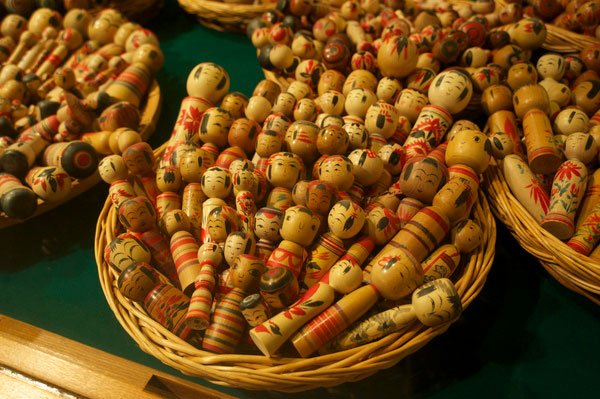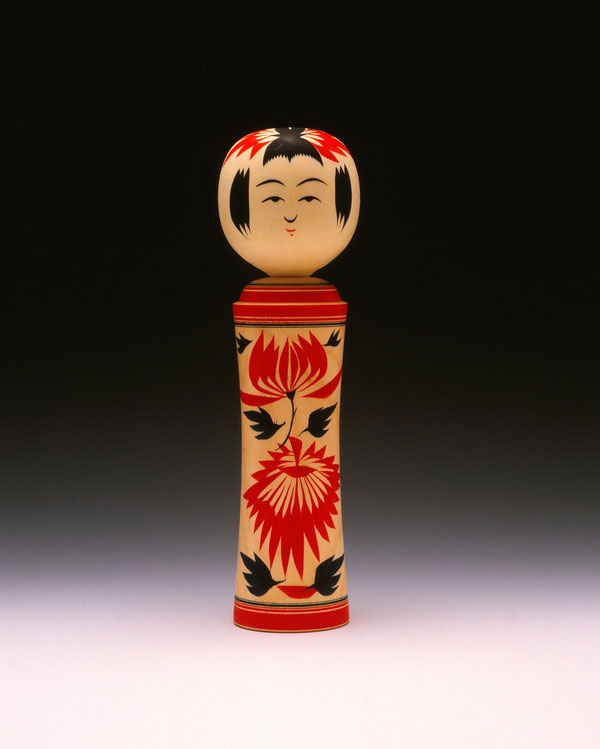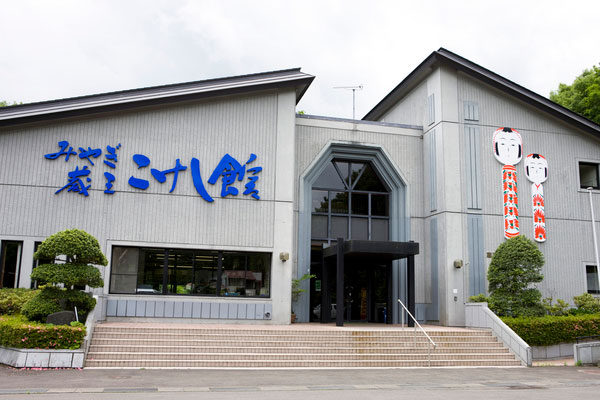
- Dolls, kokeshi
- Miyagi
Miyagi kokeshi doll Miyagi dento kokeshi
Traditional unique techniques manifest themselves
in the shape and painting of Kokeshi dolls
Description
What is Miyagi kokeshi doll ?
Miyagi Kokeshi Dolls (called Miyagi Dento Kokeshi in Japanese) are wooden dolls produced in and around the cities of Sendai and Shiraishi, Miyagi prefecture. Categorized based on region into five styles including Naruko kokeshi and Togatta kokeshi, Miyagi Kokeshi Dolls gained national recognition as a traditional craft in 1981. This craft is characterized by its charm and simplicity as a figure with just a head and body. Even with a simplified form, each doll is unique as it features the distinctive style and design that represent each region. The kokeshi production techniques and designs were handed down only within a family or from master to student, which resulted in developing the unique style of each region. There are also various restrictions on producing kokeshi dolls to maintain and protect the tradition of each kokeshi style. Miyagi Kokeshi Dolls are famous for its production process where a single artisan conducts the whole process, from timber conversion to painting and final finishing, allowing the artisan to impart individuality to the dolls while observing tradition.
History

Hyakumanto Darani or "One Million Pagodas Dharani", are a series of Buddhist prayers that were printed on paper and then rolled up and placed in a million miniature pagodas that were crafted out of wood during the Nara period (710-794) because of Empress Shotoku's wish (reigned 718-770) for national peace and security. These pagodas can be considered the oldest kokeshi dolls. Then, woodturning techniques were introduced to Omi province (now Shiga prefecture) by Imperial Prince Koretaka (reigned 844-897), and eventually trained woodturners spread all over Japan, which is said to be how kokeshi doll production developed. During the Azuchi-Momoyama period (1573-1603), woodturners settled in the Tohoku region, where Miyagi prefecture is located, and produced kokeshi dolls. This is said to be the origin of Miyagi Kokeshi Dolls. Of the five styles, Togatta kokeshi is considered to be the first produced. At the time,Togatta was flourishing with its hot springs and woodturners of the mountain villages made wooden tableware such as bowls, ladles, and trays as souvenirs for people visiting the hot springs. Meanwhile, they also used their woodworking skills to make dolls for their children and grandchildren. The dolls began to sell as souvenirs to the hot spring visitors and by the middle of the Meiji period (1868-1912), they attracted widespread popularity even among adults as Miyagi Dento Kokeshi.
General Production Process
- 1. Timber conversion and rough cutting
The five styles of kokeshi dolls within this craft have different restrictions on its production so the processes will somewhat vary. The wood that is mainly used is dogwood, but sometimes painted maple is used. Immediately after cutting a tree, the bark is stripped off and the wood is dried completely for half a year to a year. The wood material is cut to predetermined sizes and then excess parts of wood are trimmed off. Arabiki is a process of roughly cutting a wooden piece into a head and body using woodturning. Togatta kokeshi, Yajiro kokeshi, and Sakunami kokeshi require a vertical wheel while Naruko kokeshi uses a lateral wheel.
- 2. Finishing the head and body
The head and body are separately shaved with a plane. With no pencil sketches, the wooden piece is shaped using woodturning techniques, which requires the artisan’s experience and refined, outstanding skills while they feel the pieces with fingertips and visually check curve lines and thickness. The pieces are polished with scouring rush or sandpaper, and then the body is painted at upper and lower parts on a wheel. The shape of the head varies depending on the region. Other than oval shaped heads, Togatta kokeshi and Yajiro kokeshi have square-jawed heads, and Sakunami kokeshi heads are large-headed or round. The shape of the body is also decided depending on the region, with a cylindrical body slightly slim in the middle for Naruko style, and a vertical body with sloping shoulders for Togatta style. Hijiori kokeshi style allows a vertical body spreading toward the bottom along with a vertical body with sloping shoulders.
- 3. Inserting the head into the body
Naruko kokeshi uses friction produced from the body spinning on the wheel while inserting the head into the body. A phenomenon called gatako in which smoke is caused by frictional heat and a squeaking noise is made when the head is pushed in one stroke, defines their unique head insertion technique. Togatta kokeshi and Yajiro kokeshi use the techniques sashikomi or hamekomi to insert the head to the body.
- 4. Painting
Kokeshi dolls are painted with ink or dyes of colors that are specified for the parts of the doll. Black is used for the face and hair, and red and green are mainly used for a wheel-carved or kimono pattern. The rigid production rules are followed for painting the head and body. Kimono patterns for Naruko kokeshi are floral designs of chrysanthemum, peony, iris, dianthus, or a wheel-carved pattern. Togatta kokeshi kimonos are floral designs of chrysanthemum, Japanese plum, peony, cherry blossoms, and the collar of the kimono and wheel-carved patterns are painted. For Yajiro kokeshi, a wheel-carved pattern, chrysanthemum, butterfly or knotting string is used for its kimono patterns. Artisans deliver different resonance in painting even for the same kokeshi style.
- 5. Wax finishing
Plant-derived wax or white beeswax is used for wax finishing, which is an essential final production step for the kokeshi dolls. This step is important because the grain of the wood gets emphasized and a resonant finish develops.
Where to Buy & More Information
Zao Dento Sangyo Kaikan

-
Address
-
Tel.+81-224-34-2385
-
ClosedAround the New Year
-
Business Hours9am to 5pm
-
Website
See more Dolls, kokeshi
- Hakata doll
- Iwatsuki doll
- Kyo doll
- Miyagi kokeshi doll
- Edo-kimekomi doll
- Suruga-hina doll
- Edo-sekku doll
- Suruga doll accessories
- Edo Oshi-e Pictures on Embossed Fabric































































































































































































































































































